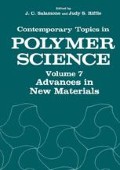Abstract
Solvent free polymer electrolytes have been extensively researched in recent years because of their potential as thin-film ion-conducting materials in high energy density batteries and electrochromic devices.1-3 Our work in this area has been chiefly concerned with the morphology and conducting properties of salt-containing comb-like poly(methacrylate)s and polysiloxanes endowed with oligo-oxyethylene side chains.4–5 Ion transport in such systems largely occurs by a free volume mechanism. This is facilitated when the polymeric component has a minimum of crystallinity and a low glass transition temperature. The presence of ion-chelating or polar additives can also have spectacular effects on the conductivity, since they can function as plasticizers or cause the dielectric constant of the material to increase. In this report the synthesis and conducting properties of lithium perchlorate and lithium triflate-containing networks of polyethylene glycols cross-linked with a hydrophobic tri- or tetrafunctional isocyanate are described. The cross-linking agents are well defined hydrosilylation products of ?,?-dimethyl-meta-isopropenylbenzylisocyanate(m-TMI). With added propylene carbonate, the elastomeric sdids have conductivities exceeding 10-3S cm-1 at 25 °C and reach values close to 10-2S cm-1 at 90°C. The salt free networks when swollen in water exhibit a strong affinity for a variety of hydrophobic molecules. The latter apparently are bound to the large hydrophobic cross-linking sites. Preliminary results of the properties of these hydrogels are also discussed.
Access this chapter
Tax calculation will be finalised at checkout
Purchases are for personal use only
Preview
Unable to display preview. Download preview PDF.
References
M.B. Armand, Polymer electrolytes, Ann. Rev. Mater. Set, 16: 245 (1986).
C.A. Vincent, Polymer electrolytes, Chemistry in Britain, 391 (1989).
D.F. Shriver and G.C. Farrington, Solid ionic conductors, Chem. Eng. News., May 20: 42 (1985).
D.W. Xia, D. Soltz and J. Smid, Conductivities of solid polymer electrolyte complexes of alkali salts with polymers of methoxypolyethyleneglycol methacrylates, Solid State Ionics, 14: 221 (1984).
D. Fish, I.M. Khan, E Wu and J. Smid, Polymer electrolyte complexes of LiC1O4 and comb polymers of siloxane with oligo-oxyethylene side chains, Brit. Polym. J., 20: 281 (1988).
G.B. Zhou, R. Fragnito and J. Smid, Siloxanes with aliphatic isocyanate groups, Polym. Bull, 22: 85 (1989).
A. Killis, J.F. LeNest, H. Cheradame and A. Gandini, Ionic conductivity of polyether-polyurethane networks containing NaBPh4, Makromol. Chem., 183: 2835 (1982).
D. Fish and J. Smid, to be published.
W. Y. Xu and J. Smid, results from this laboratory.
N.B. Graham, M. Zulfiqar, N.E. Nwachuku and A. Rashid, Interaction of poly(ethylene oxide) with solvents: Water-poly(ethylene glycol), Polymer, 30: 528 (1989).
E.S. Matsuo and T. Tanaka, Kinetics of discontinuous volume-phase transition of gels, J. Chem. Phys., 89: 1695 (1988).
E. Nwankwo, D.W. Xia and J. Smid, Salt effects on cloudpoints and viscosities of polymethacrylates with pendant oligooxyethylene chains, J. Polym. Sci, Phys. Edit, 26: 581 (1988).
J. Smid, Binding of solutes to poly(vinylbenzocrown ether)s and poly(vinylbenzoglyme)s in aqueous media, Pure Appl. Chem., 54: 2129 (1982).
Author information
Authors and Affiliations
Editor information
Editors and Affiliations
Rights and permissions
Copyright information
© 1992 Springer Science+Business Media New York
About this chapter
Cite this chapter
Wei Xia, D., Sein, A., Smid, J. (1992). Polymer Electrolytes and Hydrogels from Polyethylene Glycols Cross-Linked with a Hydrophobic Polyisocyanate. In: Salamone, J.C., Riffle, J.S. (eds) Advances in New Materials. Contemporary Topics in Polymer Science, vol 7. Springer, Boston, MA. https://doi.org/10.1007/978-1-4615-3456-3_19
Download citation
DOI: https://doi.org/10.1007/978-1-4615-3456-3_19
Publisher Name: Springer, Boston, MA
Print ISBN: 978-1-4613-6530-3
Online ISBN: 978-1-4615-3456-3
eBook Packages: Springer Book Archive

